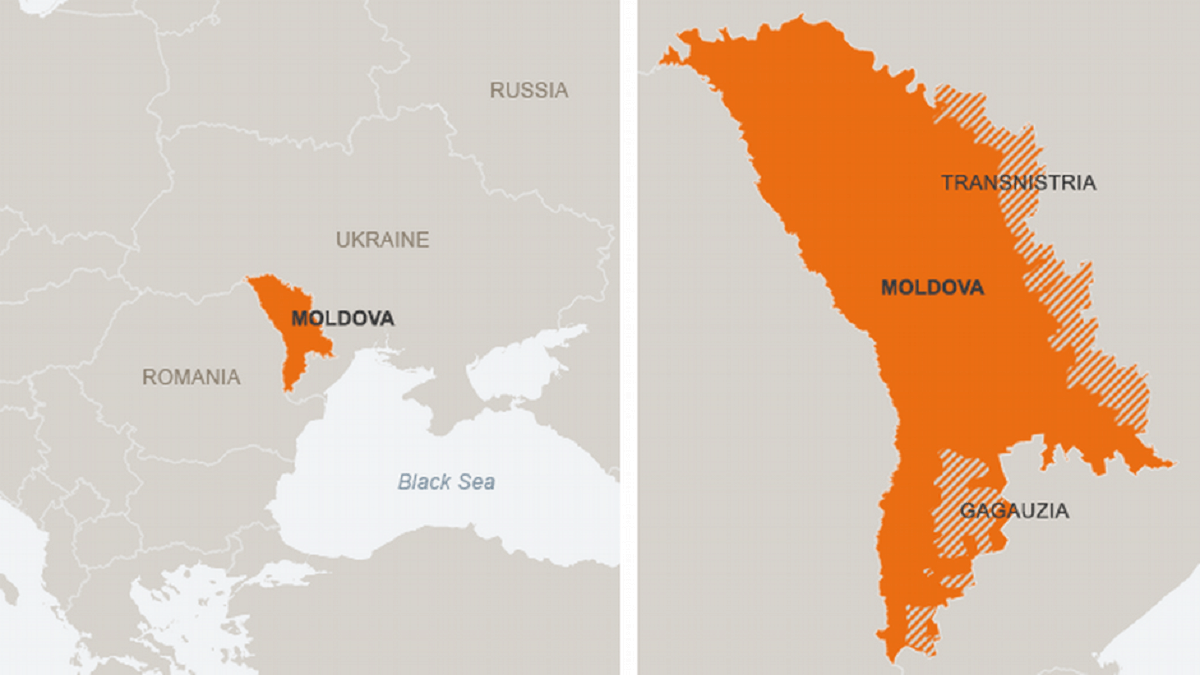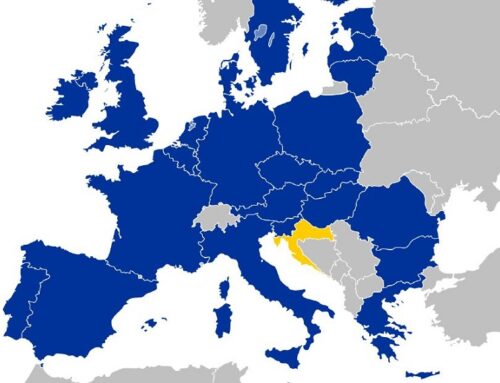Transnistria, or as it is officially called the Pridnestrovian Moldavian Republic1, is an unrecognized state with a population of about half a million people located in a narrow strip of land in the eastern part of Moldova along the Dniester river on its west and the Ukrainian border on its east. Transnistria, formerly part of the Moldavian Soviet Socialist Republic, became a battling ground of identities, ethnicities, and ideologies in the face of the looming collapse of the USSR in the early 1990s. The conflict that encompassed both political processes and military action with subsequent casualties put the young Moldovan country in a state of a civil war. Currently, it is only recognized as a state by other unrecognized republics, such as Abkhazia2, Nagorno-Karabakh (Artsakh)3, and South Ossetia4. The unique sociocultural environment of the discussed region and economic factors contributed to the escalation of the conflict in the first place and its inculcation.
Another case is represented by Gagauzia (or the Autonomous Territorial Unit of Gagauzia)5, which is located in the southern part of Moldova and composed of Orthodox Christian people speaking a Turkic language. It started its struggle for independence from Moldova even before Transnistria. However, its fight did not lead to bloodshed or casualties and was resolved by the Moldovan government granting the Gagauz people an autonomy within Moldova. Nevertheless, this process was not less dramatic than in Transnistria as it involved identity questions such as the preservation of the Gagauz language and issues of self-governance. The most illustrative result of this process is the geographic composition of Gagauzia which is a patchwork of partially isolated administrative units not forming a monolith region.
Transnistria: history, evolution, and current state
The discussed territory, Transnistria, situated on the left bank of the Dniester River represents a territory, which historically belonged to the Russian sphere of influence and has been dominated by Russian-speaking populations. On the other hand, the right bank of the river, namely Bessarabia, had for centuries been part of Romania with its distinct culture (Isachenko, 2012).
After the Socialist Revolution (1917) and the end of the imperial rule in Russia, Bessarabia joined Romania. Meanwhile, the USSR established the Moldavian Autonomous Socialist Republic (MASSR) within the Soviet Republic of Ukraine in order to exercise its influence across the river. The newly created entity was situated precisely on the left bank of the Dniester. Despite carrying the word ‘Moldavian’ in its name, ethnic Moldovans accounted for only one third of its population. In 1940, under the terms of the Molotov-Ribbentrop Pact6, the Soviet Union annexed Bessarabia and merged it with the MASSR. This move paved a way to the creation of the Moldavian Soviet Socialist Republic (MSSR). The Soviet government encouraged migration of Russians and Ukrainians to the newly formed entity (Schmidtke, 2008). Consequently, the Transnistrian region became an industrial center and attracted large numbers of Russian-speaking workers, managers, and engineers. Its economy featured heavy industry supplying the military-defense sector of the USSR. Currently, it is the most industrialized part of Moldova. Furthermore, Russians dominated the organs of coercion (such as the NKVD and militia) and the political sphere, whereas Moldovans from Bessarabia were restricted in getting political posts within the communist hierarchy. Moreover, Moldovan was not an official language of the republic (Isachenko, 2012).
Later on, such disparities in power were only heightened by an emerging nationalist movement in Moldova, which led to tensions between its multiple ethno-linguistic communities. Specifically, the main opposition force of Moldova in late 1980s and early 1990s was the Democratic Movement in Support of Restructuring which was pressing for democratization and the abolition of discriminatory practices imposed by central authorities. In May 1989, it collaborated with other politically active groups and created the Popular Front that was protesting against policies of Russification. As a result, in August that year, Moldovan was proclaimed the state language and the republican government required residents to acquire proficiency in both Russian and Moldovan. Furthermore, the Popular Front rejected previous reformist course in favor of more radical pro-Romanization agenda calling for uniting with Romania. According to William Crowther, these developments led to ‘reactive nationalism’ on the side of the Russian-speaking community against the elevation of the Moldovan language. Specifically, the issue was taken very seriously in the region of Transnistria where Russian-speaking elites felt threatened by the possibility of losing their dominant position (Bahcheli, Tozun, Bartmann, and Srebrnik, 2004).
In 1990, the Popular Front assumed power in the MSSR replacing the communist party. The newly formed government adopted new state symbols oriented towards Romania, it changed the republic’s name according to the Romanian spelling, and the supremacy of Moldovan law over the Soviet Constitution was declared. Meanwhile, the Molotov-Ribbentrop Pact was denounced and the annexation of Bessarabia by the USSR was proclaimed illegal. The most vocal against these trends were national minorities, such as the Gagauz and Russian speakers from Transnistria. In the latter, local party officials and factory managers went on strike against the language reforms. In September 1990, the Transnistrian leadership declared its independence from Moldova and allegiance to staying in the USSR as the Pridnestrovian Moldavian Soviet Socialist Republic (ibid.).
In November 1990, armed clashes happened in Dubossary between Moldovan law enforcers and Transnistrian separatists protesting against Moldovan laws in their region. Subsequently, Transnistria began forming its government organs and paramilitary units. After the collapse of the USSR, it continued state-building processes under the name the Pridnestrovian Moldavian Republic (PMR). Furthermore, its constitution was drafted, the referendum on independence was held, and the parliament passed a regulation that formed a basis for creating Transnistria’s armed forces – the Dniester Republican Guard (Isachenko, 2012). Such processes did not go unnoticed by Moldovan authorities and between December 1991 and March 1992, several armed clashes between Moldovan forces and Transnitrian paramilitary groups happened. The escalation that followed in June 1992 in Bendery left at least a thousand dead, approximately one hundred thousand people were displaced by the conflict. However, the involvement of the 14th former Soviet Army in the region, which drove the Moldovan forces out of the city, prevented further bloodshed. Subsequently, the conflict was settled by the peace agreement7 signed by Chisinau and Moscow, which, in a retrospective, ‘froze’ the division of Moldova (Dura, 2010, Popescu, 2005). Over the course of history, various negotiation formats have been applied to solve the Transnistrian problem, however, none of them have worked so far. Meanwhile, the PMR slowly developed its state-like institutions, nurtured a new generation of political elites, consolidated power, and further distanced itself from Moldova, which still recognizes Transnistria as one of its regions (Küchler, 2008).
Gagauzia: identity and peaceful resolution
In the light of nationalist developments in Moldova and its inclinations towards Romania, Gagauzia proclaimed itself an independent republic (Gagauz Yeri – literally a ‘Place for the Gagauz’) in the south of Moldova on 19 August 1990. However, the Moldovan and the Gagauzian leaders were able to agree on the devolution of power and the creation of an autonomous territorial status in 1995 (Schmidtke, 2008). However, the process of nation building was triggered by similar factors that affected the conflict in Transnistria. First, the Gagauz people’s struggle for political recognition within the USSR revolved around the issues of preserving Gagauz culture through its language and folklore. Subsequently, the Moldovan nationalist agenda and the language law became one of the stumbling stones causing discontent among the Gagauz regarding its future within the new Moldovan state. Secondly, the Moldovan government classified the Gagauz people as not indigenous to Moldova but as an ethnic group that came from Bulgaria and had no national territory. This further accelerated tensions between the Gagauz and Moldovan authorities (Ibid.).
Nevertheless, despite the presence of clearly ethnic factors, the conflict did not result in bloodshed and was settled at the negotiation table. First, shared cultural and historical backgrounds of the people inhabiting Moldova could be named as a peacekeeping element, however it did not prevent the spark of violence in Transnistria. Thus, what made the Gagauzia case different from Transnistria was a set of economic factors. Namely, the heavy industry in Transnistria represented a desired piece of fortune over which Russian-speaking and Moldovan elites engaged in a fight with one another. In contrast, Gagauzian leaders mostly were concerned with recognition of their people as a nation and guarantees preserving their cultural heritage in rural areas of Moldova. Large industrial complexes were not present in Gagauzia and thus were not an object of political struggle (Ibid.). In essence, by attaining autonomy the Gagauz people secured their stable position within the Moldovan state (Katchanovski, 2006).
The Russian factor
A special role in the hot phase of the Transnistrian conflict was played by the garrison of the 14th Army8 that became a Soviet legacy remaining in the region after the collapse of the USSR. Its military history of deployment in the area dates back to the World War II and its presence there served as both a stabilizing and destabilizing factor. To illustrate, its involvement in the conflict evolved drastically under different commanders from passivity to neutrality, and from neutrality to active participation in the fight over the city of Bendery, and to, as General Aleksandr Lebed called it, ‘armed neutrality’, which meant that the Army would intervene only in the case of being attacked (Isachenko, 2012). Also, one of key issues around the former Soviet military unit was its tremendous amount of ammunition some of which was transferred to the separatists. Currently, most of the weaponry remains in Transnistria making it one of the largest arms stockpile in Europe, whereas the remnants of the 14th Army serve as peacekeeping forces under the Russian flag and as part of the Operational Group which has a controversial status and remains an object of much criticism on the part of Moldova (Lynch, 2002).
Moreover, Russia used a number of soft power tactics to assert its influence in the region seeking maintaining its foothold in the heart of Eastern Europe. For example, Moscow encouraged issuing Russian passports to Transnistrians and contributed to the growing presence of Russian companies operating in Tiraspol (Küchler, 2008). Nevertheless, over the course of history, there have been numerous attempts to solve the ongoing issue and Russia has also been part of the Transnistria peace process, however, its real goals have not always been transparent. Building on the proposal outlined in the 2002 Kiev agreement, which highlighted the need for the federalization of Moldova as a means to solve the long-lasting conflict, Dmitri Kozak, Moscow’s main negotiator in the Moldova and, currently, Ukraine peace processes, presented his version of a roadmap with a solution to the Transnistrian issue (Schmidtke, 2008). Specifically, the so-called ‘2003 Kozak Memorandum’9 suggested providing Moldova’s regions, mainly Transnistria and Gagauzia, with veto power in a new federal legislation organ. Considering that this move would institutionalize the Russian continuous presence in the country and its ability to steer Moldova’s policy in directions convenient to Moscow, the proposal was met with criticism by the opposition and eventually turned down.
Transnistria Issue: View from the EU
According to Florian Küchler, throughout the 1990s, the European Union was preoccupied with the war on the Balkan Peninsula and Kosovo and was rather passive in the Transnitria issue. However, since 2004, the EU developed a strategy for the European Neighborhood Policy (ENP) that affected its relations with Moldova. Subsequently, an action plan for Moldova was created which outlined specific areas of reform, including democratization and economic development. An important aspect of it is that Transnistria was included in the plan. What is more, the EU’s involvement in solving the Transnistrian problem was marked by the appointment of a Special Representative for Moldova and its participation as an observer in the five-party talks (on a par with Russia, Ukraine, the OSCE, and the US as another observer). Also, the European Union set up an EC Delegation and engaged in monitoring the Moldova-Ukraine border. Besides, through the ENP framework, it tackles a variety of issues, such as economic cooperation, visa facilitation, and promotion of European values, which can have positive spillover effects on Transnistria and the conflict resolution (Dura, 2010). In addition, the EU-Moldova relations progressed fast and in 2014 the Association Agreement was signed that brought Chisinau even closer to Brussels in terms of visa-free access to the Schengen area and extended financial assistance stemming from the existing free trade deal (ibid.). Nevertheless, Brussels almost never extended its funding directly to Tiraspol through formal channels while treating the Transnistrian region as part of Moldova (ibid.).
Meanwhile, the Transnistrian conflict represents a number of direct and indirect threats to European Security. First, the withdrawal of the aforementioned stockpiles of ammunition in the region is one of the most pressing areas of concern as these weapons (mostly quite old) can fall into the wrong hands and pose both military and environmental risks. Second, the military presence of Russia in Moldova (albeit limited) serves as a factor limiting Chisinau’s freedom in conducting an independent policy without looking back at Moscow, which makes it a less reliable partner of Brussels. Furthermore, Transnistria with its semitransparent institutions and an unclear status harbors a large number of people involved in illegal activities, such smuggling, as well as human and drug trafficking, which is an area of concern given its proximity to the EU borders. Finally, the EU’s inability to effectively solve the Transnistrian issue can undermine its leadership position on the global stage and provide incentives for other neighboring states (e.g. Belarus) to turn to Russia for support (Küchler, 2008).
Moldova’s new President and pending issues
Unlike her pro-Russian predecessor Igor Dodon, the newly elected President of Moldova Maia Sandu poses herself as politician who openly welcomes European integration.10 Originally, her campaign was based on the pledges of fighting corruption and bringing economic growth11 to Moldova. However, Sandu also addressed the protracted Transnistrian issue. Mainly, she called on the withdrawal of Russian forces from Moldova along with the ammunition as she deems it the key prerequisite for restoring Moldova’s territorial integrity.12 Moscow, despite its obligations13 to pull out the forces from Moldova, is clearly interested in maintaining its positions in the region and refutes such claims insisting on the peacekeeping role of the Russian forces providing stability in the region.1415 Besides, Sandu is reluctant Russia’s proposals of the federalization of Moldova and remains vocal to find a diplomatic solution for the Transnistrian issue through multilateral formats.16
Currently, as neither side takes concrete steps, Sandu is in a difficult situation because her European aspirations collide with the harsh reality of de facto independent state of Transnistria over which the Moldovan government does not exercise any leverage.17 Specifically, if Sandu wants to achieve Moldova’s accession to the EU, she will have to work closely with the Kremlin and Tiraspol in order to bring the breakaway entity back to Moldova. Otherwise, Sandu’s pro-European plans will be threatened, as the EU would not consider Moldova as a reliable candidate to its membership until the territorial integrity is restored and Transnistria stops posing any of the security risks outlined before. Meanwhile, giving in to the federalization demands from Russia and Transnistria would weaken her position both domestically and in the eyes of the European community.1819 Thus, she is facing a complicated diplomatic task revolving around questions of what compromises the new Moldovan President can make and how much she is ready to sacrifice to put an end to the 30 year-long struggle.
References:
1 en.president.gospmr.org
2 mfa-pmr.org/ru/dDJ
3 mid.gospmr.org/en/SQR
5 old.gagauzia.md/index.php?l=en
6 digitalarchive.wilsoncenter.org/document/110994.pdf?v=61e7656de6c925c23144a7f96330517d
7 mfa-pmr.org/en/SfB
8 www.ww2.dk/new/army/armies/14gvoa.htm
9 regnum.ru/news/polit/458547.html
10 www.dw.com/en/moldovas-maia-sandu-i-want-to-be-the-president-of-european-integration/a-56089364
11 neweasterneurope.eu/2020/11/18/moldovans-elected-an-anti-corruption-president-avoiding-a-colour- revolution/
12 www.eurointegration.com.ua/interview/2020/11/20/7116719/
14 www.mid.ru/en/web/guest/foreign_policy/news/-/asset_publisher/cKNonkJE02Bw/content/id/4461719#9
15 www.mid.ru/en/web/guest/meropriyatiya_s_uchastiem_ministra/-
/asset_publisher/xK1BhB2bUjd3/content/id/4463903
16 tass.com/world/1228559
17 lossi36.com/2021/04/07/catch-22-in-moldova-maia-sandu-and-the-transnistrian-question/
18 www.neweurope.eu/article/the-prospects-for-a-settlement-on-transnistria-under-a-sandu-presidency/
19 https://blog.prif.org/2021/01/28/breaking-the-vicious-circle-can-the-new-moldovan-president-sandu-succeed- in-balancing-relations-with-the-eu-and-russia
14th Guards Combined Arms Army, n.d. http://www.ww2.dk/new/army/armies/14gvoa.htm.
“AGREEMENT on the Principles of a Peaceful Settlement of the Armed Conflict in the Pridnestrovien Region of the Republic of Moldova.” Ministry of Foreign Affairs, July 21, 1992. http://mfa- pmr.org/en/SfB.
Bahcheli, Tozun, Barry Bartmann, and Henry Srebrnik, eds. De facto states: the quest for sovereignty. Routledge, 2004.
“Briefing by Foreign Ministry Spokeswoman Maria Zakharova, Moscow, .” Briefing by Foreign Ministry Spokeswoman Maria Zakharova, Moscow, November 27, 2020 – News, November 27, 2020. http://www.mid.ru/en/web/guest/foreign_policy/news/-
/asset_publisher/cKNonkJE02Bw/content/id/4461719#9.
Crowther, William, ‘The Politics of Ethno-National Mobilization: Nationalism and Reform in Soviet Moldavia’, Russian Review, 50, 2 (1991), pp. 183–203.
Dura, George. “The EU and Moldova’s Third Sector: Partners in Solving the Transnistria Conflict?.” (2010).
Deutsche Welle. “Moldova’s Maia Sandu: ‘I Want to Be the President of European Integration’: DW: 30.12.2020.” DW.COM, n.d. http://www.dw.com/en/moldovas-maia-sandu-i-want-to-be-the-president- of-european-integration/a-56089364.
“Foreign Minister Sergey Lavrov’s Remarks and Answers to Media Questions at a News Conference Following the Meeting of the CSTO Council of Foreign Ministers, Moscow.” Foreign Minister Sergey Lavrov’s remarks and answers to media questions at a news conference following the meeting of the
CSTO Council of Foreign Ministers, Moscow, December 1, 2020 – Ministers’ speeches, December 1, 2020. http://www.mid.ru/en/web/guest/meropriyatiya_s_uchastiem_ministra/-
/asset_publisher/xK1BhB2bUjd3/content/id/4463903.
“Gagauzia Is an Autonomous Territorial Unit within the Republic of Moldova.” The legal status of Gagauzia as component of the Republic Moldova, n.d. http://old.gagauzia.md/index.php?l=en.
Isachenko, Daria. The making of informal states: Statebuilding in Northern Cyprus and Transdniestria. Palgrave Macmillan, 2012.
“Istanbul Document.” OSCE, 1999. http://www.osce.org/mc/39569.
Katchanovski, Ivan. Cleft Countries: Regional Political Divisions and Cultures in Post-Soviet Ukraine and Moldova. Stuttgart: Ibidem-Verlag, 2006.
Küchler, Florian. The Role of the European Union in Moldova’s Transnistria Conflict. ibidem- Verlag/ibidem Press, 2008.
Lynch, Dov. Russian Peacekeeping Strategies in the CIS: the Cases of Moldova, Georgia and Tajikistan. Houndmills: Palgrave, 2002.
“Moldovans Elected an Anti-Corruption President, Avoiding a ‘Colour Revolution.’” New Eastern Europe
– A bimonthly news magazine dedicated to Central and Eastern European affairs, November 18, 2020. https://neweasterneurope.eu/2020/11/18/moldovans-elected-an-anti-corruption-president-avoiding-a- colour-revolution/.
Official website of the President of the Pridnestrovian Moldavian Republic – Main, July 6, 2021. http://en.president.gospmr.org/.
Polianskii, Mikhail. “Breaking the Vicious Circle: Can the New Moldovan President Sandu Succeed in Balancing Relations with the EU and Russia?” PRIF BLOG, January 28, 2021.
https://blog.prif.org/2021/01/28/breaking-the-vicious-circle-can-the-new-moldovan-president-sandu- succeed-in-balancing-relations-with-the-eu-and-russia/.
Popescu, Nicu. “The EU in Moldova-Settling conflicts in the neighbourhood.” EuroJournal. Org-Journal of Foreign Policy of Moldova 12 (2005).
“Protocol on Cooperation and Consultations between the Ministry of Foreign Affairs of the Pridnestrovien Moldavian Republic and the Ministry of Foreign Affairs of the Nagorno-Karabakh Republic.” Ministry of Foreign Affairs, July 4, 2001. http://mid.gospmr.org/en/SQR.
“Ribbentrop Non-Aggression Pact, 1939 Secret Supplementary …,” n.d. https://digitalarchive.wilsoncenter.org/document/110994.pdf?v=61e7656de6c925c23144a7f96330517 d.
Roussel, Evguenia. “Catch-22 in Moldova: Maia Sandu and the Transnistrian Question.” Lossi 36. Lossi 36, April 1, 2021. https://lossi36.com/2021/04/07/catch-22-in-moldova-maia-sandu-and-the- transnistrian-question/.
Schmidtke, Oliver, and Serhy Yekelchyk. Europe’s last frontier?: Belarus, Moldova, and Ukraine between Russia and the European Union. Palgrave Macmilan, 2008.
TASS. “Moldovan President-Elect Speaks in Favor of Saving 5+2 Format of Talks on Transnistria.” TASS, November 26, 2020. https://tass.com/.
Waller, Nicholas. “The Prospects for a Settlement on Transnistria under a Sandu Presidency.” New Europe, December 11, 2020. http://www.neweurope.eu/article/the-prospects-for-a-settlement-on- transnistria-under-a-sandu-presidency/.
“ДОГОВОР МЕЖДУ ПРИДНЕСТРОВСКОЙ МОЛДАВСКОЙ РЕСПУБЛИКОЙ И РЕСПУБЛИКОЙ АБХАЗИЯ О
ДРУЖБЕ И СОТРУДНИЧЕСТВЕ.” Министерство иностранных дел, January 18, 2017. http://mfa- pmr.org/ru/dDJ.
“Договор Между Республикой Южная Осетия и Приднестровской Молдавской Республикой о Дружбе и Сотрудничестве.” Министерство иностранных дел, n.d. http://www.mfa- rso.su/node/1561.
“‘Меморандум Козака’: Российский План Объединения Молдовы и Приднестровья.” ИА REGNUM, May 23, 2005. https://regnum.ru/news/polit/458547.html.
“‘Російські Війська Мають Піти з Придністров’я, а Крим – Це Україна’: Інтерв’ю Маї Санду.” Європейська правда, November 20, 2020. https://www.eurointegration.com.ua/interview/2020/11/20/7116719/.





